| Back to Back Issues Page |
 |
|
Bangkok Travelbug September 15 Ancient Town of Kanchanaburi August 26, 2015 |
| Hello
Ancient Town of Kanchanaburi in brief The Ancient Town of Kanchanaburi was a fortified town in Tambon Lat Ya about 17 km north-west of Kanchanaburi city during the mid-Ayutthaya and early Rattanakosin periods (mid-16th C and late 18th C). All that remains of this ancient town today are ruins of three temples and the rubble that was once an old fort. 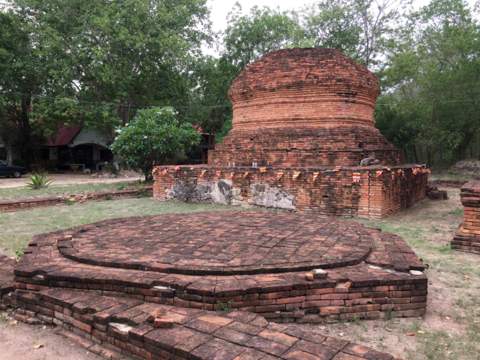
Ruins of Wat Pa Lelai, Ancient Town of Kanchanaburi The ancient town straddles the Khwae Yai valley which, readers will recall from last month’s article, was one of the main avenues of movement from old Burma into Siam, the Khwae Noi valley being the other. Movement along the upper stretches of the Khwae Yai is very restricted today because of the reservoir created by the Srinakharin Dam. The source of the Khwae Yai River can be traced through the mountain ranges all the way to Burma. In the old days, before the river was dammed, the Khwae Yai valley would have been one of the main avenues of entry into central Siam. In fact 24 km further north-west of the ancient town where the valley broadens out is the location of a historical park commemorating a major battle in the Burmese-Siamese War during the reign of King Rama I (1782 – 1809). Nine Army Battle In 1785, early in the First Reign, the Burmese launched a massive invasion of Siam with 100,000 men organised into five armies with incursions in nine areas.
The Siamese troops consisted of about 70,000 men organised into four armies.
The Burmese forces from the north were held up at Lampang and Nakhon Sawan. At Ratchaburi, the Siamese after an initial setback, defeated the Burmese force there. These blocking actions isolated the main battlefield in Kanchanaburi where the critical battles were being fought. It was here in the hills of Kanchanaburi that the Burmese main force was decisively defeated and withdrew to Burma. With the main threat in the central region removed, the Siamese turned north, defeated the Burmese at Nakhon Sawan and went on to relieve Lampang. In the south at Chumphon, the Siamese gave ground initially, then diverted forces from the central region to the south and drove the Burmese back to Burma. Because of the number of forces involved in the invasion, that battle is known today as the Nine Army Battle and the park called the Nine Army Battle Historical Park. 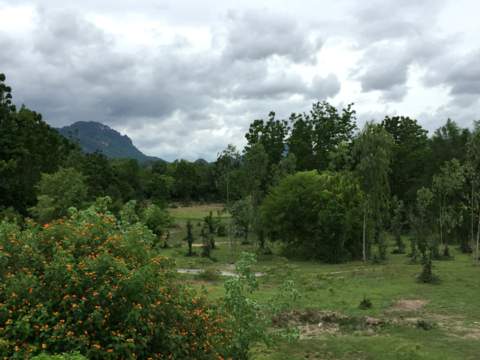
The Khwae Yai valley viewed from the Nine Army Battle Historical Park Table of contents Map of the Nine Army Battle Click on this link for a bigger map Table of contents Tour of the Ancient Town With the main battles being fought in the Kanchanaburi area, there must have been lots of troop activity in the area around the Ancient Town of Kanchanburi. There is no record of the size of this fortified town. But we know that it occupied roughly a square area bounded by the Khwae Yai River to the south and the Taphoen River, a tributary of the Khawe Yai, to the west. It was big enough to have three temples with four forts located at each corner. This fortified town served as an outpost guarding the north-western border with Burma. The ruins of the Ancient Town of Kanchanaburi were excavated and studied by the Fine Arts Department in 1968. Restoration works were made in 2009 together with the Kanchanaburi provincial administration. Let’s take a tour of the ruins which consists of:
Wat Pa Lelai The ruins of Wat Pa Lelai are near the main highway 3199 and can be seen from the road. It’s located in a quiet forested area and according to the caretaker it’s actually functioning as a temple with a resident monk. 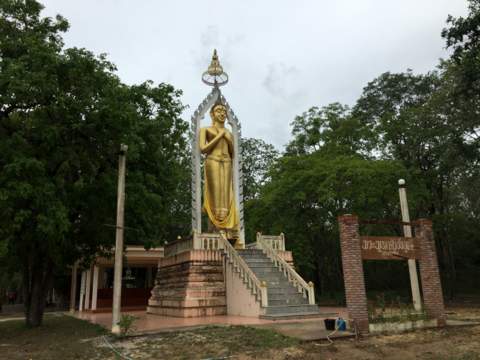
Huge Buddha statue facing the road The temple was renamed Pa Lelai from the special posture of the huge Buddha statue which was installed to replace an older statue. 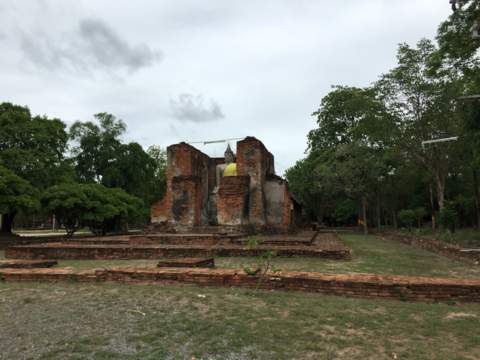
The Buddha statue that gave the temple its name It’s an unusual temple with very basic facilities; just a few wooden buildings, an altar and shrine located at the edge of a wooded area. 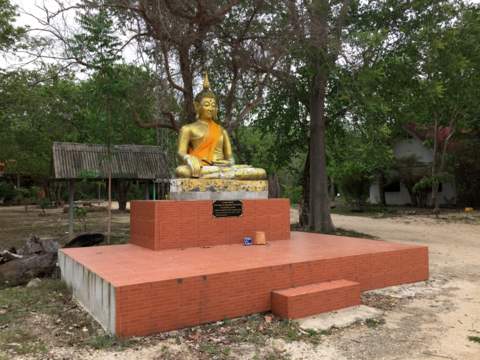
Another Buddha statue 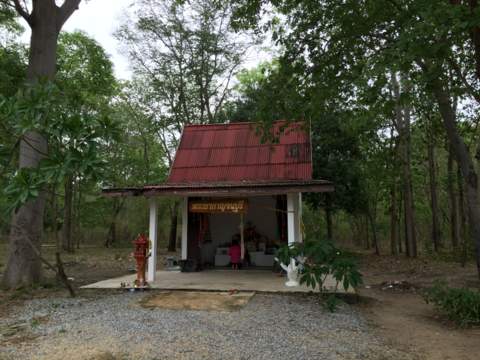
Shrine and altar in the temple grounds 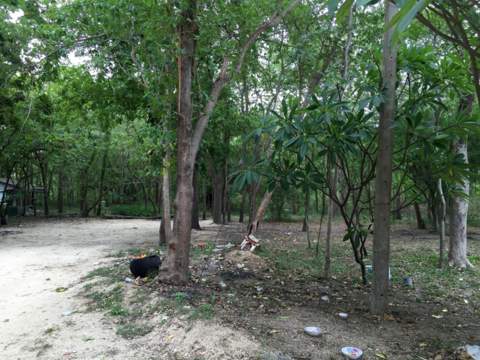
Woods around the temple Wat Khun Paen The ruins of Wat Khun Paen are further from the main road. The temple faces the west and it’s estimated to be built in the 17th C during the Ayutthaya period. 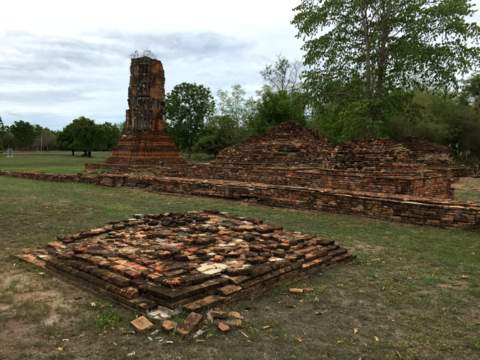
Wat Khun Paen 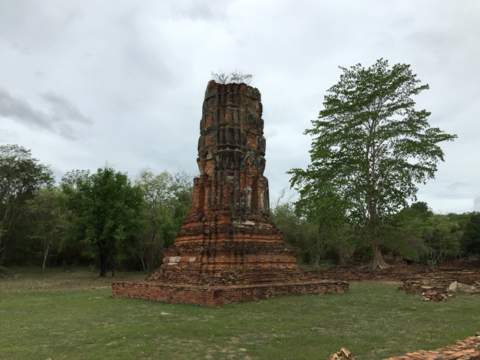
Remaining chedi Wat Mae Mai Wat Mae Mai is located across the road from Wat Khun Paen and faces the east, only the bases of the surrounding wall, buildings and what appears to be chedi are left of the ruins. 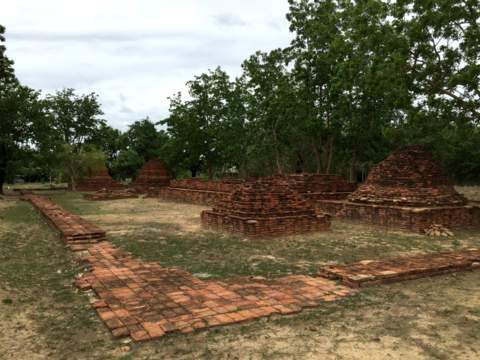
Wat Mae Mai 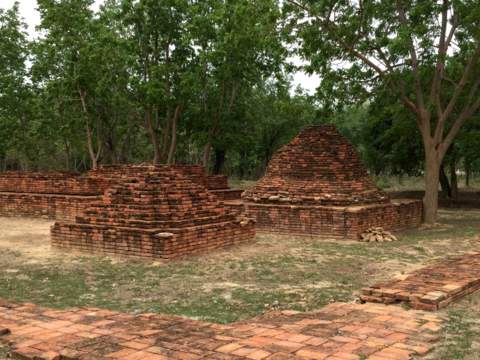
Base of two chedi Old Fort Originally four forts were constructed, one at each corner, for the defence of the ancient town. I could only locate one of them and almost missed it if not for the signboard. These old forts were built with stones and bricks to form walls of about four metres high. There’s no sign of connecting walls between the forts, these were probably log fences and have been destroyed. 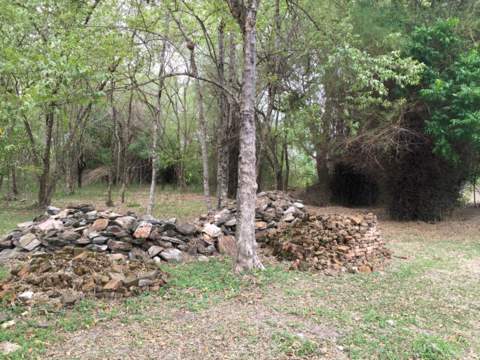
What’s left of the old fort These ruins are in the worst condition among all the ruins in the ancient town; just rocks pushed into a pile! It’s a pity; this old fort wasn’t reconstructed and restored. 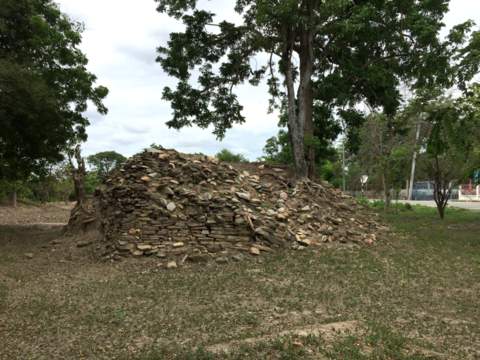
Piles of rubble The green hills of Kanchanaburi have borne silent witness to the ravages of war over the last 300 years. Today peace reigns over these green hills again and may it continue to be so. 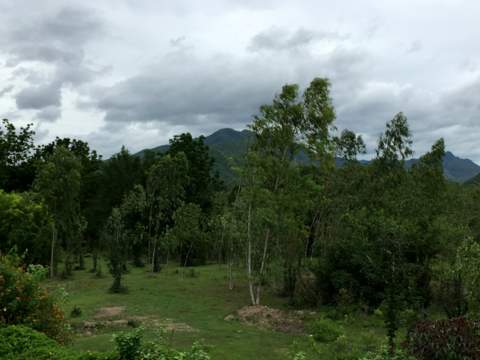
The hills of Kanchanaburi Table of contents Map to the Ancient Town of Kanchanaburi Click on this link for a bigger map How to get to the Ancient Town Kanchanaburi From Bangkok get on to Boromarajajonani Road or Phet Kasem Road depending on which is more convenient for you. You will eventually get on to highway 4, Phet Kasem Road and hit Ban Pong, Ratchaburi. Continue on to highway 323 till you get to Kanchanaburi city. Drive through the city along Saeng Chuto Road. At the major junction after you’ve left the city, go straight onto highway 3199. Continue on highway 3199 till you pass another junction where Lat Ya is located. The Ancient Town of Kanchanaburi is about 3 km north of Lat Ya town. It’s on the left and you will spot Wat Pa Lelai first. The Nine Army Battle Historical Park is 23 km to the north of the ancient town along highway 3199. Caution There’s a discrepancy between the numbering of the roads around Kanchanaburi city. In the Kanchanaburi city road signs and the Google map, Saeng Chuto Road which passes through the city is numbered 323 and the road bypassing the city is numbered 367. In the Thai highway maps, the road through the city is simply Saeng Chuto Road and the bypass road highway 323. Both roads eventually join up at the north-western edge of the city and continue onto highway 323. Opening hours Ancient Town of Kanchanaburi is open every day from 0800 – 1700 hours. Admission is free Address Ancient Town of Kanchanaburi Tambon (sub-district) Lat Ya Amphur Mueang Kanchanaburi (city district) Kanchanaburi Thailand Table of contents
If you enjoyed reading this e-zine, please forward it to a friend. If you received this from a friend and found it interesting, please subscribe at Bangkok Travelbug. What do you think of the Bangkok Travelbug? We love to hear from you What other subscribers have said Till next month then. Eric Lim Tour Bangkok Legacies Find us on Facebook Copyright@2008-2015 Tour Bangkok Legacies All rights reserved |
| Back to Back Issues Page |